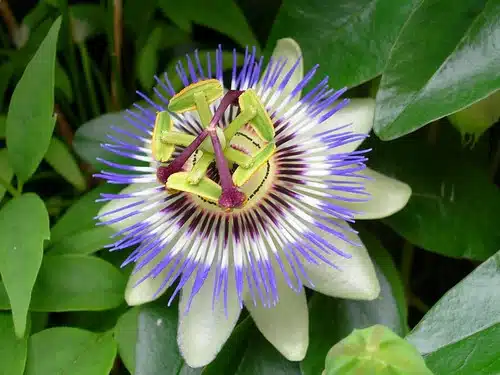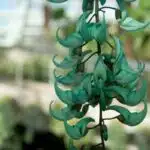Passionflower, also known as Passiflora, is a beautiful and unique plant that can be grown indoors. This tropical vine produces stunning flowers with vibrant colors and intricate patterns that are sure to captivate any onlooker. Besides its aesthetic appeal, passionflower has been used for medicinal purposes for centuries due to its calming effects on the nervous system.
Caring for passionflower requires some attention to detail, as it needs specific conditions to thrive. However, with the right care and attention, this plant can grow into a beautiful addition to your indoor space. In this article, we will provide a comprehensive guide on how to care for passionflower plants indoors, including tips on optimal growing conditions, watering and fertilizing techniques, pest control methods, and more. Whether you’re a seasoned plant enthusiast or a beginner looking to add some greenery to your home or office space, this guide will provide all the information you need to successfully grow and care for your passionflower plant.
Understanding Passionflower Plant Anatomy
Passionflower plants are native to tropical regions of the Americas, and they are known for their beautiful flowers and unique growth patterns. Understanding the anatomy of these plants is essential for proper care and maintenance. The passionflower plant’s anatomy consists of three main parts: the root system, stems, and leaves.
The roots are underground structures that anchor the plant in place and absorb water and nutrients from the soil. Passionflower plants have a fibrous root system that spreads out horizontally instead of growing deep into the ground. The stems grow upwards from the roots, and they can be either woody or herbaceous depending on the species. The leaves grow from nodes along the stem, and they can be simple or compound with five to nine lobes.
Passionflowers are known for their strikingly beautiful flowers that come in a range of colors, shapes, and sizes. The flowers typically have five petals arranged in a radial pattern around a central disk. Some species have large showy flowers with intricate patterns, while others have small unassuming blooms. Passionflowers also produce edible fruits that resemble small berries.
Understanding passionflower plant anatomy is crucial for providing optimal care for your indoor plant. Identifying each part of the plant will help you understand its growth patterns, which will aid in selecting an appropriate location within your home. In the next section, we will explore how to find the perfect indoor spot for your passionflower plant to thrive in its new environment.
Finding The Perfect Indoor Spot For Your Passionflower
Ironically, finding the perfect indoor spot for your passionflower can seem like a daunting task, but it is essential for optimal growth and flowering. The first factor to consider is indoor lighting. Passionflowers require bright, indirect sunlight for at least six hours a day to thrive. Therefore, select a spot near a window that receives plenty of natural light, but avoid placing the plant in direct sunlight as it may damage its delicate leaves.
The second factor to consider is temperature control. Passionflowers prefer warm temperatures between 70-80°F during the day and cooler temperatures between 60-65°F at night. Avoid placing the plant near drafty windows or doors as this may cause temperature fluctuations that can stress the plant and inhibit its growth.
To ensure your passionflower thrives indoors, consider the following nested bullet point list:
- Select a location with bright, indirect sunlight.
- Avoid placing in direct sunlight.
- Maintain warm temperatures during the day and cool temperatures at night.
- Avoid placing near drafty windows or doors.
- Consider using artificial lighting if natural light is insufficient.
By taking these factors into consideration and providing optimal indoor conditions, your passionflower will flourish with vibrant foliage and blooms year-round. In the subsequent section, we will discuss soil requirements for optimal growth and how to prepare your passionflower’s soil for planting.
Soil Requirements For Optimal Growth
When it comes to growing passionflowers, the type of soil you use is crucial. These plants require well-drained soil that is rich in nutrients. The ideal soil for passionflower growth should be loose, friable, and loamy. This allows for good drainage while also retaining enough moisture to keep the roots hydrated.
There are several types of soil that are suitable for growing passionflowers. One popular choice is a mix of peat moss, perlite, and vermiculite. This combination provides excellent drainage and aeration while also retaining enough moisture to support healthy root growth. Another option is a mixture of sand and loam, which provides good drainage and nutrient retention.
It’s important to note that soil pH plays a significant role in passionflower growth. These plants prefer slightly acidic soils with a pH between 6.0 and 6.5. If the soil pH is too low or too high, it can affect the plant’s ability to absorb nutrients from the soil. To ensure optimal growth, it’s recommended to test your soil regularly and adjust the pH as needed using lime or sulfur.
Next up: watering techniques for passionflower plants, which are just as important as choosing the right soil for optimal growth.
Watering Techniques For Passionflower Plants
If you’re looking for a plant that demands constant attention and care, then the passionflower is definitely not for you. But if you want to add some color and vibrancy to your home with a low-maintenance plant, then look no further than this beautiful indoor beauty. One of the most important aspects of caring for your passionflower is getting its watering schedule right.
Frequency schedule is crucial when it comes to watering your passionflower. During the growing season, which starts from spring until early fall, water at least once a week. However, be careful not to overwater your plant as it can lead to root rot and other issues. Signs of overwatering include yellowing leaves, wilting, and soil that feels constantly moist.
Choosing the right pot for your passionflower is just as important as getting its watering frequency down pat. Make sure that the pot has enough drainage holes to prevent water from accumulating at the bottom. This will help ensure that your plant’s roots are properly aerated and won’t suffer from dampness-related issues like rot or fungal growths. Another tip is to use well-draining soil mixtures that allow excess water to drain out easily.
As much as we all would love our plants to thrive on their own, they do need some assistance in order for them to reach their full potential when it comes to blooms. In order for this beautiful indoor plant to bloom beautifully, fertilizing is key! In the next section, we’ll go through some tips on how best to fertilize your passionflower so it blooms magnificently!
Fertilizing Your Passionflower For Maximum Blooms
After discussing the proper watering techniques for your passionflower plant, let us now move on to the next essential aspect of its care: fertilizing. Fertilizing is an important factor in promoting healthy growth and maximum blooms. It provides essential nutrients that are not naturally present in the soil.
When it comes to fertilizing your passionflower plant, you have a choice between organic and synthetic fertilizers. Using organic fertilizers is highly recommended as they are environmentally friendly and gentle on your plants. It is best to use a slow-release fertilizer with balanced nutrients that will nourish your plant over time.
The frequency of fertilizing your passionflower depends on its growth rate and environment. Generally, it is best to fertilize once every three weeks during the growing season, which usually falls between spring and fall. However, be mindful not to over-fertilize as this can lead to nutrient burn or damage to your plant’s roots. With proper fertilization, you can expect your passionflower to bloom abundantly and thrive for years to come.
Moving forward, pruning and training your passionflower vine is another critical aspect of keeping it healthy and beautiful.
Pruning And Training Your Passionflower Vine
Pruning techniques are essential for maintaining the health and shape of your passionflower vine. The best time to prune is in late winter or early spring before new growth appears. Begin by removing any damaged, dead, or diseased wood. Next, thin out any overcrowded stems by cutting them back to the point where they meet another stem. This will allow for better air circulation and light penetration throughout the plant.
Training methods are also important for keeping your passionflower vine under control. As a vining plant, it can quickly become unruly if left untrained. One popular training method is to use a trellis or other support structure to guide the plant’s growth upward. As new shoots appear, gently weave them through the support structure, being careful not to damage them in the process.
Another training method involves pinching back the growing tips of young shoots to encourage branching and fuller growth. This technique is especially useful if you want to create a bushier, more compact plant instead of a long, sprawling vine. With regular pruning and training, your passionflower vine will thrive and produce beautiful flowers year after year.
Next up on our care guide is dealing with common pests and diseases that may affect your passionflower vine. By following these simple steps for pruning and training, you’ll be well on your way to preventing many common issues from arising in the first place.
Dealing With Common Pests And Diseases
Common pests and diseases can sometimes affect your passionflower plant. Prevention methods are always the best course of action when it comes to dealing with these issues. Pests such as aphids, spider mites, and mealybugs can be kept at bay by regularly cleaning and dusting leaves, using insecticidal soaps or oils, and introducing natural predators like ladybugs or lacewings.
In addition to pests, passionflower plants can also be susceptible to fungal diseases such as powdery mildew or root rot. To prevent these issues from arising, avoid overwatering your plant and ensure proper drainage. If you do notice signs of a fungal infection such as yellowing leaves or discolored spots on the foliage, there are natural remedies you can try before resorting to chemical fungicides. These include neem oil sprays, baking soda solutions, or even a simple mixture of water and vinegar.
Overall, keeping a close eye on your passionflower plant is the best way to prevent any pests or diseases from taking hold. Regularly inspecting the leaves for any signs of damage or discoloration will allow you to catch any issues early on before they have a chance to spread. Additionally, incorporating natural remedies into your care routine can help keep your plant healthy without relying on harsh chemicals.
Moving forward, if you want to propagate new passionflower plants from an existing one, there are several methods you can try.
Propagating Passionflower Plants
Have you ever found yourself wanting to propagate your passionflower plant? Perhaps you want to gift a cutting to a friend or expand your collection. Whatever the reason may be, propagating your passionflower plant can be an easy and rewarding process. In this section, we will discuss propagation techniques and maintaining healthy cuttings.
Propagation techniques for passionflowers include stem cuttings and layering. Stem cuttings involve taking a portion of the stem with several leaves attached and rooting it in soil or water. Layering involves bending a low-growing branch down to the ground, covering it with soil, and allowing it to root before cutting it from the parent plant. Both methods are effective, but stem cuttings are easier for beginners.
Maintaining healthy cuttings is essential for successful propagation. Make sure to keep the soil moist but not waterlogged, as excess moisture can cause rotting. Place the cutting in bright but indirect light and avoid direct sunlight, which can damage or wilt the leaves. With proper care, your passionflower cuttings will thrive and grow into new plants that you can enjoy for years to come.
As you wait for your new passionflower plants to grow, consider adding support structures for your passionflower vine. These plants are vigorous climbers that require sturdy support such as trellises or fences. Adding these structures not only helps your plant grow upward but also adds aesthetic appeal to your space. With these tips in mind, you’ll be well on your way to propagating healthy passionflower plants and creating a stunning display in no time!
Adding Support Structures For Your Passionflower Vine
Passionflowers are known for their beautiful, showy flowers and their ability to climb and vine around objects. As your passionflower vine grows, it will need support structures to help it climb upwards. DIY support structures can be made from a variety of materials such as bamboo poles, stakes, or trellises. These structures not only provide support for the plant but also add visual interest to your indoor garden.
Alternative climbing methods include using moss poles or coir totems. Moss poles are vertical supports that are covered in sphagnum moss, which provides a natural surface for the plant to climb on. Coir totems are similar but are made from coconut fiber instead of moss. These alternative methods work well for indoor gardeners who prefer a more natural look or want to avoid using synthetic materials.
When installing support structures, it is important to consider the weight and size of your passionflower vine. A heavy vine will require sturdier support than a smaller one, while a larger vine may need additional support points along its length. Additionally, make sure that the structure is securely anchored in place so that it does not topple over and damage your plant. With proper support in place, your passionflower vine can continue to grow and thrive in its indoor environment.
Moving on from adding support structures, it is important to know how to troubleshoot common issues with passionflower care. From pests such as spider mites and aphids to diseases like powdery mildew and root rot, there are several challenges that passionate gardeners may face while caring for these plants indoors. In the next section, we’ll discuss some tips on how to identify and treat these issues so that you can continue enjoying your beautiful passionflower vine with ease.
Troubleshooting Common Issues With Passionflower Care
After providing support structures for your passionflower vine, it is important to keep an eye out for any pest prevention measures. Just like any other indoor plant, passionflowers are susceptible to pests such as spider mites, aphids, and whiteflies. These pests can cause damage to the plant’s leaves and flowers, which can lead to stunted growth or even death. To prevent these pests from infesting your passionflower plant, make sure to inspect it regularly and remove any dead or diseased leaves.
Another issue that may arise with passionflower care is nutrient deficiencies. Passionflowers require a balanced amount of nutrients to thrive and produce healthy blooms. A lack of certain nutrients can cause yellowing leaves, stunted growth, and poor flower production. To prevent nutrient deficiencies, make sure to fertilize your passionflower plant regularly with a balanced fertilizer. Also, consider adding compost or organic matter to the soil to provide additional nutrients.
In addition to pest prevention and nutrient deficiencies, proper watering is crucial for the health of your passionflower plant. Overwatering can lead to root rot while underwatering can cause the leaves to wilt and drop off. To ensure proper watering, check the soil moisture level before watering by sticking your finger about an inch into the soil. If it feels dry at that depth, then it’s time to water. Water thoroughly until it drains out of the bottom of the pot and avoid letting the plant sit in standing water.
To keep your passionflower plant healthy and thriving requires attention to detail when it comes to pest prevention measures, nutrient deficiencies and proper watering techniques. By following these guidelines on how best care for this beautiful indoor plant you will be rewarded with vibrant blooms that will add a touch of elegance wherever they are displayed in your home or office space!
Conclusion
Passionflower plants are a beautiful addition to any indoor garden. Their unique anatomy and stunning blooms make them an eye-catching feature in any space. To ensure optimal growth, it is important to find the perfect spot for your passionflower plant, provide the right soil conditions, water it properly, fertilize it regularly and deal with common pests and diseases.
When choosing a location for your passionflower plant, consider its lighting needs. It requires bright but indirect sunlight to thrive. The right soil mix will also be essential for optimal growth. A well-draining potting mix with organic matter is recommended. Watering should be done carefully as overwatering can lead to root rot while under watering can cause the plant to wilt.
In conclusion, growing a passionflower plant indoors requires attention to detail and proper care. By understanding its anatomy and providing the right conditions such as light, soil, water and nutrients, you can enjoy a healthy and vibrant plant that will produce stunning blooms. Proper care also involves dealing with common pests and diseases that may affect your plant’s health such as spider mites or fungal infections. Regular monitoring of your plant’s growth will enable you to detect any issues early enough before they become major problems. With patience and perseverance in caring for your passionflower plant, you will have a beautiful addition to any indoor garden that will bring joy year-round.
As horticultural writers often ask rhetorical questions to emphasize certain points or ideas, one may ask: “What could be more rewarding than watching your passionflower grow from seedling to blooming vine?” Indeed, the process of nurturing a passionflower plant can be both challenging yet fulfilling; providing an opportunity for learning about botany as well as creating a serene atmosphere in your home or office space.
Image Credits
- “Wild Passionflowers” by mnadi (featured)








![How To Grow And Care For Corkscrew Vine 10 Strophanthus preussii [Corkscrew Flower, Poison Arrow Vine, Spider Tresses, Tassel Vine] Apocynaceae](https://green-life.blog/wp-content/uploads/2023/04/KW5aFOG5S3jq-150x150.jpg.webp)




















